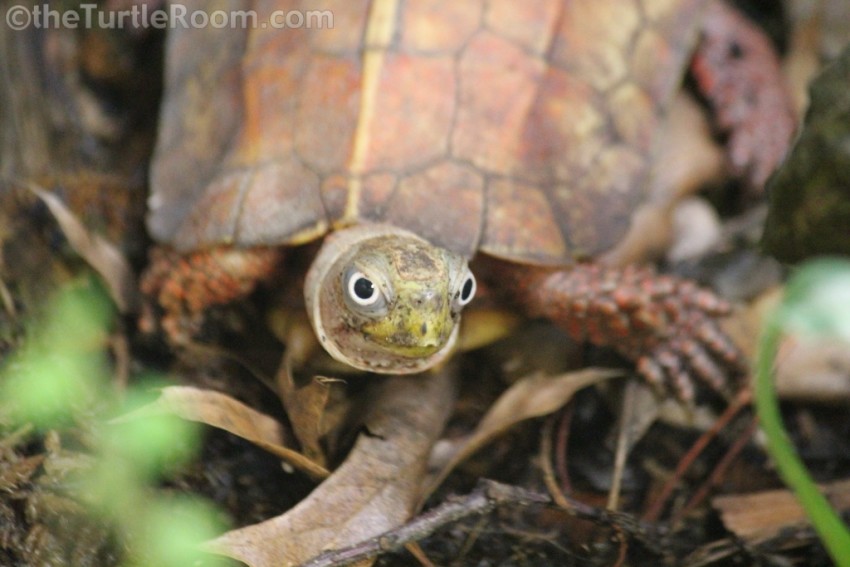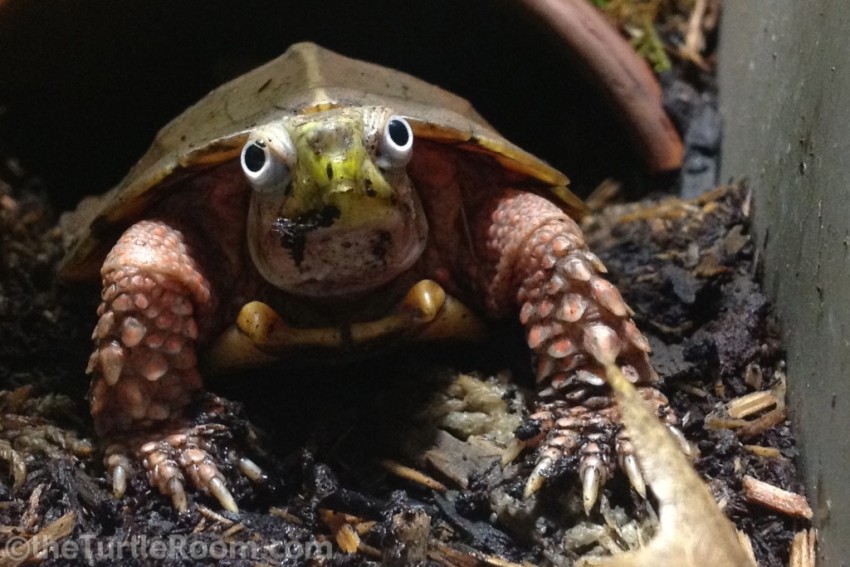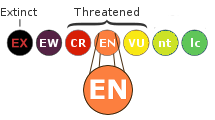Description and Identification
Geoemyda spengleri is among the world’s smallest turtles, with a SCL length of no more than 11cm (4.3”). The carapace is somewhat elongated, rather flattened, and widest in the posterior half of the body. Its color varies from a yellow-brown to gray-brown and dark-brown. Darker than the rest of the carapace, three well-developed keels run down the carapace, with the vertebral keel being the most prominent. The marginal scutes are strongly serrated, each posterior marginal formed like a sharp tooth. The plastron is black with a yellow border, almost as long as the carapace, and a significant anal notch. There are no inguinal or axillary scutes. The head is flat with a strongly pronounced, but not notched, beak. The color of the head is usually olive to brown with a yellow band extended from the orbits to the neck; these markings are more evident in juveniles and females. This species is most-recognized and well-known for its large, beautiful eyes – particularly in males who display a striking white iris. The iris is often off-white to light-brown in females. A male’s tail will also be longer and thicker than the female tail.
-
 Primary ID: Beak and Round Eye with No Transverse BarPrimary ID: Beak and Round Eye with No Transverse Bar
Primary ID: Beak and Round Eye with No Transverse BarPrimary ID: Beak and Round Eye with No Transverse Bar -
 Secondary ID: 3-Keeled Carapace (Middle Keel Strongest) with Serrated MarginalsSecondary ID: 3-Keeled Carapace (Middle Keel Strongest) with Serrated Marginals
Secondary ID: 3-Keeled Carapace (Middle Keel Strongest) with Serrated MarginalsSecondary ID: 3-Keeled Carapace (Middle Keel Strongest) with Serrated Marginals -

-

-

-

-

-

-

-

-

-

-

Distribution
Geoemyda spengleri is found in northern and central Vietnam and southern China in Guangdong, Guangxi, and Hainan Island. There are unconfirmed reports of sightings in Borneo and Laos.
Native Habitat
The Black-Breasted Leaf Turtle of Southern China and Northern Vietnam is almost completely terrestrial, spending much of its time hiding among leaf litter in the forrest. This species is rarely seen in water and prefers wild, wooded mountain areas, where it is found close to small creeks and wetlands.
Wild Diet
Omnivorous in diet, it eats small invertibrates such as insects and earthworms, as well as various fruits. The fondness of snails or slugs in Geoemyda spengleri has been noted as well.
Behavior
Like many chelonians, Geoemyda spengleri often do not move unless there is a specific reason for them to do so. As Rudloff (1986) has noted, they will sit motionless for hours, heads held high and eyes wide open. This statuesque stance is immediately put on hold by the movement of live prey items. However, they are easily distracted by motion, and they may abandon the prey in their jaws to pursue other turtles that may be trying to feed simultaneously.
Recently, studies have shown an impressive means of visual accommodation during hunting in Geoemyda spengleri (Henze, 2003). While these turtles are at rest, surveying their environment, their eyes move independently from one another. However, when a prey item is introduced in their vicinity, Geoemyda spengleri will fix both eyes on it's target and keep both eyes there even when the vision of one eye is obstructed. This coupled accommodation is only observed during binocular prey fixation. The pupil of the eye also responds quickly to changes in ambient light intensity.
Reproduction
Geoemyda spengleri is a sexually dimorphic species. Adult males have white irises and females have beige to tan irises. The male also has a longer and thicker tail than that of the females and females tend to have a more striped pattern on the head. The clutch size is just one or two, and there may be up to three clutches in a single nesting season. The eggs measure about 43 x 18 mm, and incubation takes roughly 66 days at 28 degrees Celsius.Care Difficulty:
AdvancedHabitat Difficulty:
IntermediateCaptive Habitat
If you decide to keep Geoemyda spengleri adults together, it is important to provide multiple hides, sight breaks and water dishes to avoid stress in submissive animals. We keep our G. spengleri adults and youngsters individually. Adults are only brought together for breeding purposes, which reduces stress and helps the keeper maintain detailed notes on parentage and overall health. When deciding whether to keep G. spengleri together or not, one should keep this in mind. A friend of theTurtleRoom recently lost two male G. spengleri when their reproductive organs we severed by bites from other animals in the enclosure that had perhaps mistaken them for a live prey item. Individually, housing for G. spengleri does not need to be very large. 18-Gallon rubbermaid tubs can be used as a minimum for one adult. The tall, opaque walls reduce stress and help maintain humidity.
Geoemyda spengeri can be kept with success on a substrate mixture of organic topsoil, peat moss and cypress mulch. The topsoil and cypress mulch retain moisture and helps increase overall humidity of the terrarium, while peat moss lowers ph and wards of mold that may grow in damp areas. Oak leaves can be used in enclosures to help reduce stress. One would think that a turtle shaped like a leaf would do well in a situation where they could hide amongst fallen leaves. We use clay pot halves or cork bark rounds as hides and various items as water dishes in adult enclosures. Hides can be arranged to provide "look-out" areas where spengleri can rest and observe their surroundings.
Live plants should be incorporated within the enclosure to provide security to the animals, raise the humidity, and help break down waste in the substrate. Many Southeast Asian plants can be found for sale as house plants. Korean and Upside Down Ferns and Japanese Peace Lillies have been used with great success. One seasoned G. spengleri keeper once told us that "if the plants are thriving, the turtles should as well." Basking heat sources are not as important in this species as proper humidity levels. The importance of UVB is also unknown, as they live under heavy canopy in the wild. Some keepers do not keep their animals with a UVB overhead, while those who do use a UVB source seem to do so for peace of mind. We use a UVB strip light over all of our G. spengleri enclosures for that very reason.
The enclosure is sprayed daily to maintain humidity. Uneaten food items like earthworms are left to inhabit the enclosure. We add springtails to our G. spengleri habitats as well. These small insects work to break down waste left behind by the turtles. Springtails can be purchased from our friends at NEHerpetoculture.com.
Captive Diet
Our animals are fed a mixture of live food, pellets, fruits and a lean meat mixture. Most often, live prey items like earthworms, crickets, snails, slugs, and pill bugs are appreciated greatly. A mixture of pellets can be offered in a dish with chopped fruit. We prefer to use Mazuri Aquatic Turtle Diet above all other pellets and a variety of fruits are accepted by our adults. Geoemyda spengleri seem to prefer over ripened fruit that is red in color. Strawberries, grapes, blueberries, and tomatoes have all been eaten here. The meat mixture we use is a combination of lean ground turkey meat, chicken feed and vegetables, usually finely chopped carrots. This mixture was an idea borrowed from the care regiment of a zoo close to one of tTR's breeders.
Temperatures
It is widely believed that G. spengleri should be kept between 68 and 80 degrees. Our adults are left to experience temperatures in a much larger range than that, allowing for nighttime drops and seasonal fluctuations. Temperatures in the mid 90s have been experienced temporarily during the summer and temperatures in the 40s have been experienced temporarily during the winter, both with no ill affect. We aim to maintain our G. spengleri above 60 and below 85 degrees. In our experience, when this species is subjected to temperatures below the mid 60s, they slow down greatly, sometimes not moving for weeks. While we are still unsure whether such extreme temperature fluctuations are necessary, we feel that they, coupled with a healthy diet rich in fruit, may play an important role in producing healthy hatchlings.
Breeding and Incubation
Breeding in Geoemyda spengleri is relatively straight forward. When kept separately, males will run towards females seconds after introduction. Incubation takes roughly 70 days and can be done so at fluctuating room temperatures. Many seasoned keepers believe that such fluctuation in incubation temperatures helps to produce larger, stronger hatchlings. It is widely believed that G. spengleri eggs will die if exposed to temperatures above 80 degrees. TheTurtleRoom breeders have had eggs reach temperatures as high as 92 degrees temporarily with no issues (though these temperatures have not been sustained for long periods of time). It is more likely that prolonged temperature extremes will cause more harm. At this time, a lack of males in the United States, particularly in the U.S. SSP for this species, has led to many keepers incubating eggs at a lower temperatures. As far as we know, it has not been proven at this time that G. spengleri possesses TSD, but U.S. keepers should strive to provide incubation temperatures between 68 and 80 in hopes of producing males.
Common Health Issues
During the turn of the century, many Geoemyda spengleri were available for incredibly low prices in the United States. Then, one could often find freshly imported adults for as low as $30 USD. Today, breeding adults often fetch close to $1000 USD. In those early years, this species earned a reputation as being difficult to acclimate. Those individuals that were acclimated may have taken years to breed and/or produce viable eggs in captivity as well. However, once acclimated, this species is a rather easy animal to care for, besides their need for a varied diet consisting of various live food items. Hatchlings are a different story. They are much more fragile, timid and picky than their close relatives, Geoemyda japonica.
Hatchling Captive Habitat
We keep our hatchling Geoeymda spengleri in sterilite tubs filled with sphagnum moss and an inch of water. Inside those tubs, the turtles are provided with a vine of pothos ivy to hide under and a half of a plastic plant pot as a hide. This more aquatic environment is chosen for its ability to maintain a high humidity level. The keeper must select an area for the hatchlings to reside that stays within the high 70s.
Hatchling Captive Diet
Hatchling Geoeymda spengleri will eat a diet similar to adults. Smaller worms should be selected as moving prey is always much more appreciated. Pellets and fruit may be offered as well, but pellets may not be eaten and fruit will almost certainly be refused. We chop earthworms into small, manageable pieces for our hatchlings.
If you would like to contribute to the photo gallery of any turtle or tortoise species, please email us at [email protected]. You will be credited for any photos you contribute.
| Geoemyda spengleri |
| (Gmelin, 1789) |
| IUCN Red List: |
 |
| Endangered A1cd+2cd (2000) |
| Order: | Testudines |
| Suborder: | Cryptodira |
| Superfamily: | Testudinoidea |
| Family: | Geoemydidae |
| Subfamily: | Geoemydinae |
| Genus: | Geoemyda |
| species: | spengleri |
| Other Common Names: |
| Spengler's Turtle, Black-Breasted Leaf Turtle, Black-Breasted Hill Turtle, Vietnamese Leaf Turtle, Indo-Chinese Serrated Turtle, Scalloped Leaf Turtle, Vietnamese Wood Turtle |
| CITES: | Appendix II |
Author:
Editors: Stephen J. Enders, Anthony Pierlioni, Chris Leone, Andrew S. Weber, Ben Forrest, and Andrew Hermes
Sources
Disclaimer: The Species Profiles - Natural History, Care Guide, and Photo Gallery database is an educational resource. It does not cover all Chelonian species in the world, nor does it include all the latest scientific information about the species covered. Though we edit our accounts for accuracy, we cannot guarantee all information in those accounts. While theTurtleRoom's staff and contributors provide references to books and websites that we believe are reputable, we cannot necessarily endorse the contents of references beyond our control.

This work by theTurtleRoom is licensed under a Creative Commons Attribution-NonCommercial-ShareAlike 4.0 International License.
























































